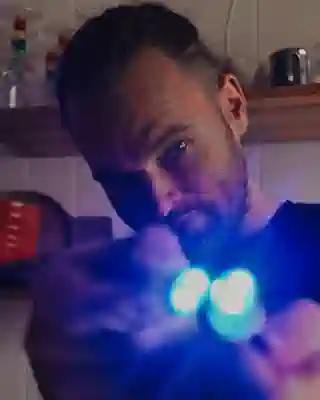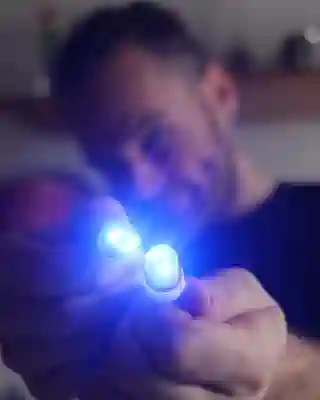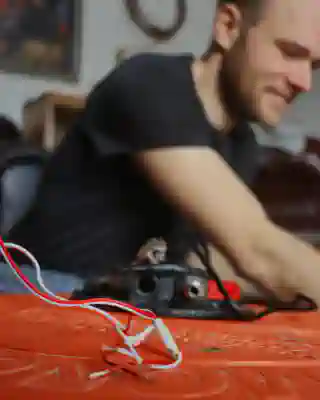
Water Filtration: UV Light as an Effective Solution
Filtering water with light? Yes, it's possible! In this article, we'll tell you about our latest renovation measure and explain how it actually works.

Attention! We do not guarantee that you won't get sick from consuming the filtered drinking water. We only provide tips on how we proceeded and what we believe works. Please don't sue us!
So far, we haven’t filtered our water, even though we’ve been on the road for so long. Fortunately, we haven’t had any problems so far. Touch wood!
Of course, it also depends on where the water comes from. We’ve never had a bad feeling about the water sources we’ve used. For those where we were skeptical - whether it was because of the water’s red color, an unpleasant smell, or a nearby factory - we preferred to go without and bought water in case of emergency. Additionally, we didn’t find any water sources on the Canary Islands.
Whether you ultimately need a water filter or not, you have to decide for yourself. In this article, we want to introduce our latest DIY project: UV water filtration.
The problem with harmful substances in water is that you can’t necessarily see the danger.
What is UV Water Filtration?
UV water filtration is essentially about purifying water through light!
Filtering water with light? Is that possible?
Our answer: YES!

I think the word “filtering” is used somewhat incorrectly here, but I’ll explain more about that below.
The idea for this system came to us when we were researching water filters and an acquaintance ended up with a filter that filtered out coarse particles but not bacteria and viruses. The result was that she was sick in bed after two days with stomach pains and the like. There are now many water filters on the market. Some are mobile, others are specifically designed for campers and are permanently installed. But this is not about other filters here. Basically, this is not about a filter, but about a simple and effective method of purifying your water in a different way.
Possible germs and bacteria that can occur in drinking water: Legionella, Pseudomonas, Enterococci. Furthermore, salmonella, cholera bacteria, Enterobacter, noroviruses, or rotaviruses can occur.
Basics
Jo is a biologist and has worked on the development of rapid PCR tests for the detection of viruses and bacteria. Corona is just one example here. In the laboratory, cleaning surfaces using UV light, for example, is a common method.
Ultraviolet (UV) light is a form of electromagnetic radiation with a wavelength shorter than that of visible light but longer than X-rays. UV light ranges from 10 to 400 nanometers (nm) in wavelength. It is invisible to the human eye, but some animals can perceive UV light.
UV light is divided into three categories:
-
UV-A (long-wave UV radiation): This light has wavelengths from 315 to 400 nm. It constitutes the majority of the UV radiation reaching the Earth. UV-A rays are less energetic than UV-B and UV-C rays but can still cause skin damage and are associated with premature skin aging.
-
UV-B (medium-wave UV radiation): UV-B light has wavelengths from 280 to 315 nm. It is responsible for most sun-induced skin damage, such as sunburn, skin aging, and skin cancer. The Earth’s ozone layer absorbs some UV-B radiation, but a significant amount reaches the Earth’s surface.
-
UV-C (short-wave UV radiation): UV-C rays have the shortest wavelengths, from 100 to 280 nm. They are the most energetic and harmful types of UV radiation. The atmosphere largely absorbs UV-C rays, preventing them from reaching the Earth’s surface. UV-C is often used for disinfection purposes as it damages the DNA of microorganisms, thus preventing their reproduction. We exploit this property in our water tank.
Good to know: In many regions of Europe, tap water is excellent and of high quality. In most cases, bacteria and viruses come from contaminated pipes.
Our UV Water Purification
In our article about our water system , we described our tank, pump, and installation of our UV lamps.
When purchasing UV light, make sure that the bulbs emit UV-C rays. There are UV bulbs that emit only UV-A and UV-B.
It’s really simple. After filling the tank, we turn on the UV light and turn it off again after about 20 minutes. This should be enough time to destroy the DNA of the viruses and bacteria. Once the DNA is destroyed, both viruses and bacteria are no longer dangerous. You might understand now why I don’t see this as a filter, because the light doesn’t filter out the bacteria and viruses but kills them and renders them harmless.

Pros and Cons
Advantages:
- Easy installation! You only need a UV lamp in the tank.
- Kills 99.9% of microbes.
- Environmentally friendly.
- Easy operation.
Disadvantages:
- Requires electricity.
- Does not clean suspended particles, rust, or medication residues. Those can only be removed by filtration.
- Does not neutralize the taste of water.
Application Area
There are many water filters on the market that either completely ignore the neutralization of bacteria and viruses or filter both suspended particles and bacteria. However, these are usually more expensive and larger. They also require a certain water pressure for the water to be pushed through the filters. However, we don’t always have this water pressure, for example, when filling up at natural water sources or water pumps.
That’s why we opted for a small mobile filter through which we can fill the water into the tank. However, thanks to the UV treatment, we are also protected against diseases.
In this sense, greetings to all of you out there!
Yours, Jo